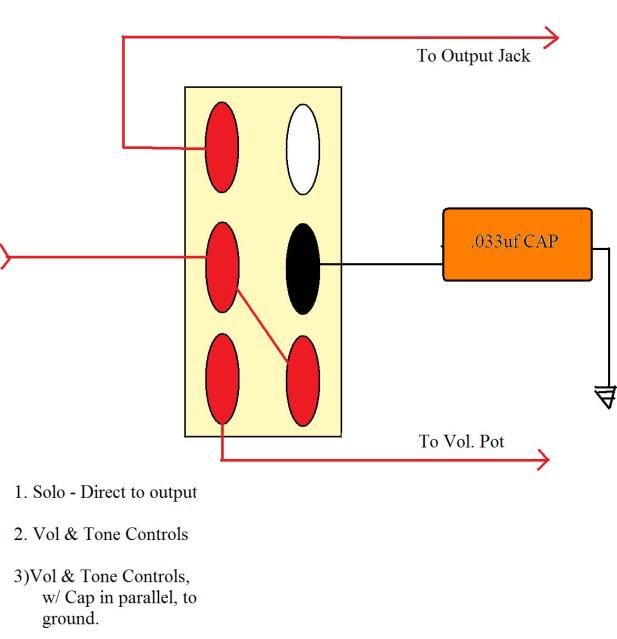|
|
Post by newey on Aug 30, 2011 17:40:46 GMT -5
This is going in my travel guitar, so I thought I'd post it. This is the answer to the question no one (but me) was asking- what Nutzy™ thing can you do with one DPDT On-On-On switch and a single coil pickup? The stock HB in my Hofner travel guitar never sounded like much, so it's going, replaced by a GFS Dream 90 (P90-in-a-HB-form). Keeping the stock V & T pots, which are 500K (because of the stock HB), so it ought to be much brighter, but the cap will knock it back some.  This is somewhat similar to Esquire wiring, the original SC scheme! |
|
|
|
Post by Ro_S on Nov 22, 2018 12:29:57 GMT -5
Does the capacitor position setting achieve exactly what the so-called strangle switch does on a Fender Jaguar? Or does it do the exact opposite?
|
|
|
|
Post by sumgai on Nov 22, 2018 21:10:56 GMT -5
Ro_s, Does the capacitor position setting achieve exactly what the so-called strangle switch does on a Fender Jaguar? Or does it do the exact opposite? It would do the exact opposite - it's wired in parallel with the pup/vol pot, so it will behave exactly like a tone control that's turned all the way down.
When a cap is placed in series with the pup/etc, that's when the "strangle effect" occurs.
Short bit of history, for you "young-timers":
When Leo was busy inventing the Esquire (nee Broadcaster) and Telecaster, there were really only two kinds of music that were popular with the general populace of Southern California at the time: Country&Western (to include Hawaiian slack-key), and Jazz*. Known players of jazz were used to "mellow" tonality, thus Leo included an "instant" switch position that accomodated them. This idea carried over from that first single-pup Esquire to the Tele, though with a slight difference. In fact, it wasn't until Leo decided he could do better (his idea to build a "Killer guitar"), that he started listening in earnest to country players such as Rex Gallion and Bill Carson, hiring them on as mutual designers of what became known to one and all as the Stratocaster.
Also, recall that the Jazzmaster appeared in 1958 (prototyped as early as 1956) with its "special" switchable circuit for Jazz players, allowing for two preset tonalities. While it never caught on with jazz musicians (just give a listen to Jimmy Bryant on a Tele for a clue as to why that might have been so), it did catch on with early rockers (see the still image below).
Dick Dale (the acknowledged Father Of Loud) didn't appear on Leo's radar until early 1960 or thereabouts. (Depending on who's story you believe.  ) )
The Jaguar didn't come on the scene until 1962. It's only saving grace was that it featured a 24" scale, the rest of it was bone-stock Fender parts. The "Bright" switch didn't really catch on, because most amplifiers of that day didn't have much in the way of low-frequency loudness anyways - it was already always "bright". Well, until the Showman and Dual Showman showed up, that is. 
Jimi Hendrix played Jazzmasters with the Isley Brothers, starting probably in 1959, but I've seen other articles that state he didn't get his first one unitl 1962 or thereabouts. Who cares, he played a mean Rhythm & Blues!

Bill Carson (I didn't spend any real time searching for a "live" video):
Jimmy Bryant with Speedy West (there's lots more of these two on Youtube):
</History lesson>
sumgai
* Rock and it's descendents were still a few years away. Mexican-flavored music was almost unknown outside of those communities, and when it did appear, it would be a long time before electrification of such would enter the mainstream.
|
|
|
|
Post by newey on Nov 26, 2018 23:01:10 GMT -5
SG's right, it's not like the "strangle switch". The cap gives a "fixed bassy tone", as Fender called it on the Esquire. As you flick the switch, you go from "bright" (i.e., pots bypassed) to "medium" (with both pots active and available for turnin') to "low" with the capacitor in circuit (which also comes with a loss of output to an extent).
IMO, for a single coil, one pickup guitar, this is the most sensible option. With both pots at max, flicking the switch through the three positions is a bit like a tone switch, but the second setting can be preset to an extent based on the pots' settings. You can set up the middle and/or cap settings position for a rhythm sound, then flip to the brightest setting for solo work.
If , however, I do it over again, I might want to play with the cap value a bit, the loss in that setting is a bit much.
|
|